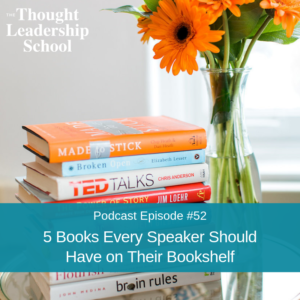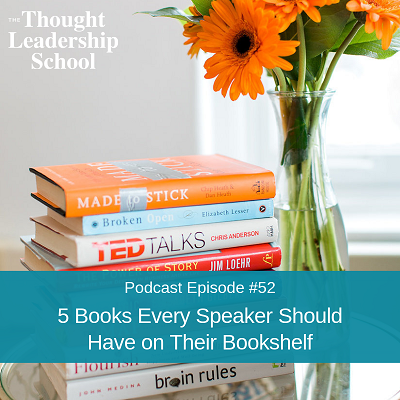
Crafting a talk is an incredibly personal endeavor, especially when integrating elements of your own story or transformation into your message. While looking inward for inspiration often forms the core of your talk – especially if you’re a client of mine – being supported by the wisdom and research of other inspiring thought leaders can take an already great talk to an entirely new level.
There are five books that I come back to over and over again as a speaker, and I want to share them with you. These five books cover technical elements of speaking – how to create great slides, how to keep an audience’s attention, and similar questions – as well as ideas about great storytelling and what makes a message really stick in someone’s mind.
Listen in as I go through my list of five books that should be on every speaker’s bookshelf and share how they’ve impacted my journey as a speaker and coach. I’ll tell you a little bit about each book, who it’s by, and how to use it to make your speaking stand out. Each one is a treasure trove of information – I bet your reading list will be five books longer by the end of this episode!
What You’ll Learn from this Episode:
- Why tapping into your own story is a central element of a compelling talk.
- How to weave other thought leaders’ work into your speaking.
- Five of my favorite books that will support your journey to crafting and delivering a powerful, engaging talk.
- Why we have to keep in mind the audience’s attention span when coming up with a speech or presentation.
- Why storytelling is such a common element found in great speaking.
Listen to the Full Episode:
Featured on the Show:
- Download Beyond Applause: Make a Meaningful Difference through Transformational Speaking for free and gain access to a four-part course on becoming a thought leader in your industry.
- Presentation Zen: Simple Ideas on Presentation Design and Delivery by Garr Reynolds
- Made to Stick: Why Some Ideas Survive and Others Die by Chip Heath and Dan Heath
- Resonate: Present Visual Stories that Transform Audiences by Nancy Duarte
- Resonate Process from Duarte
- Brain Rules: 12 Principles for Surviving and Thriving at Work, Home, and School by John Medina
- Long Story Short: The Only Storytelling Guide You'll Ever Need by Margot Leitman
- The Moth Podcast
- The Thought Leadership Community Facebook Group
- I've collected all of the amazing free resources I offer for you, my dear listener, over at the VIP Podcast page. Check it out!
Full Episode Transcript:

I do a lot of talk crafting, for myself and for and with my clients. The most important element of this process is tapping into our stories, our experience, and our expertise. This is a deeply personal process. Once we do that, though, our job as thought leaders is to make that content as captivating, engaging, and useful as possible. For this part, I have a treasure chest of books that I call upon for guidance and ideas. I cannot wait to share these with you. You are definitely going to want these on your bookshelf.
Welcome to The Thought Leadership School podcast. If you're on a mission to make a difference in the world with your message, you are in the right place. I'm Michelle Berry Franco, and I'm thrilled that you're here.
Hello my thought leadership friends. How are you? I'm sitting here in my office, surrounded by books, more on that in a minute, drinking a chocolate smoothie. Chocolate smoothie, like my brain is like, “Wait, is it a treat? Is it healthy?” which, I'm pretty sure, is why I love it so much.
We are actually going to talk about our brains quite a bit today. Fun, right? I can't wait. So the work we do as thought leaders really is deeply personal. At least, that's how it is here at The Thought Leadership School, because we help people mostly in personal development arenas like coaching and wellness, creative endeavors. We're building businesses and making a difference in the world based on our own stories of transformation.
So the work we do as thought leaders is deeply personal. At least, that's how it is here at The Thought Leadership School, because we help people mostly in personal development arenas like coaching, wellness, creative endeavors. We help them, you, share your stories and expertise in service of others. This means there's a whole lot of inward-looking for answers, for the content that goes into our thought leadership. And yet, as thought leaders, we also know that there is so much wisdom outside of us that can support us, right? We can tap other people's thought leadership to make our own expression, our own thought leadership even better.
It's funny how it's this sort of circular thing. As thought leaders, we tap other thought leaders to help us be even more powerful. So when I'm crafting a talk for myself or with a client, we do spend the vast majority of our time looking inside for stories, for expertise, for wisdom. I turn them inward. I point them toward their own experience, what they know to be true, their own life lessons. And then, once we have that foundation in place, we blossom their talk with a full, magic mix of content. This is where we bring in research, outside stories and expertise, audience engagement activities, that actually come from other sources.
So this podcast episode is very meta, because today, I'm both going to show you how that's done by calling upon outside thought leaders inside this episode, and I'm going to share with you some of my favorite resources so that you can use them in your own thought leadership. Because I speak on speaking, voice, self-expression, those kinds of things, see, very meta, these resources apply both to looking at how I'm creating this episode overall and then also, as resources within this episode.
I'm going to share five books with you that I believe every speaker should have on their bookshelf. I'll share with you about the book, why I love it, and how I think you can best use it in your own speaking and thought leadership. So let's dive in. I'm super-excited for you to hear about these books and get them on your bookshelf and use them, because they really are game-changers in allowing you to make the greatest impact out there in the world with your message.
The first book I want to share with you is one of the first books that I bought when I started venturing into the speaking world in a more committed way. I've always been talking about communication and public speaking, right? I started way back when I was speaking myself in high school and then I taught public speaking in college. But it wasn't until 2008 when I started my business and then a couple years into that that I really started to see the power of using speaking on behalf of growing a business, a brand, a mission.
At that time, I was still teaching college, and one of the things that I found most perplexing was how ugly that slide seemed to be everywhere I looked. So I was looking for examples to show my students, as I was working with some clients outside, some corporate clients, I just couldn't believe that all of these examples were so unattractive. I wasn't a designer or artist by any stretch. I'm still not, but I've always loved beauty in a very active way. I seek out beauty. Every once in a while, I'd see some gorgeous slides, and I realized that the whole slide thing could be done really differently than I'd seen. It could be done simply and really powerfully and effectively, but I just didn't quite know how to do it myself at that time.
Enter Presentation Zen, by Garr Reynolds. This book is a classic in the presentation world. If you're presenting, you've got to have it and refer to it. Garr Reynolds makes the case for the image-based slide, and you've seen these, a big compelling image with maybe no words or maybe one or two words or maybe just a large number that's making a point. It's clear that these slides are designed to supplement a talk. They are not meant to give all of the information themselves. This is such a beautiful lesson that we all need to get.
Our slides are our assistant, and Garr Reynolds does such a great job of showing us how to create those kinds of image-based slides. Essentially, he says six words or less, whenever possible, and using large, compelling images. Now this isn't the only way to create great slides, and he'll even say that in the book. He shows other kinds of chart slides and that kind of thing. Sometimes more words is better, but not a lot of words. And six words is really a high bar for many of us. If you're sharing a quote, for example, you'll likely have more than six words, so it doesn't apply to everything.
But I love that he sets a standard of simplicity and the power of compelling images through his book, Presentation Zen. You'll see many examples of great slides. He also shows some before and after that really bring home the point that slides can be done way better and even more simply. I love Presentation Zen. Get a copy of that book if you don't have it. You're going to refer to it regularly.
As I began to facilitate more corporate and organizational trainings, I realized that while slides are definitely an issue, and they often still are, there was an even more fundamental struggle for presenters inside of organizations, and I absolutely see this with my thought leadership clients now. They didn't know how to articulate their sometimes very complex ideas in a way that was simple and memorable for their audiences. It was like they couldn't see the problem with the way they were communicating because they were so familiar with their content that it all felt very clear and understandable to them. Maybe this makes sense to you. When you're an expert, when you're a deep expert in an area, in a topic area, you're so familiar with the content that it just … When you explain it, it feels like the clearest thing in the world to you.
When I first learned the concept of the knowledge gap from Chip and Dan Heath in the book Made to Stick, I knew I had to share it in my presentation skills trainings for organizations, especially. It turns out that this concept, and so many others from Made to Stick, apply for most of my speaker and thought leader clients. You're going to love the super-clear examples that Chip and Dan Heath use in the book Made to Stick. They make each concept of their SUCCESs model so actionable in your own speaking.
In case you're wondering, SUCCESs, which is the acronym that they use for the different chapters in their book and the elements of their model, SUCCESs stands for simple, unexpected, concrete, credible, emotional, stories, and then they just have a little small s after that so that they can spell the word success. But they don't have a second s. So basically, each of these concepts helps a person create an even stickier message. These are the elements of sticky messages. You're going to want to learn and apply these elements for sure, and they do such a great job of sharing examples and stories so that you understand how you can apply each of these to your own speaking messages. So get yourself a copy of Made to Stick by Chip and Dan Heath, and have that on your speaker bookshelf.
As I got to work with higher level speakers, I could see that there was a pattern or rhythm to the most compelling presentations and talks. Though I didn't know how to name it or describe it, it was just this sense that I had. I could tell that there was something that they were doing consistently across the great speakers, but I didn't know what it was. So thank goodness that Nancy Duarte is so into research and presentation skills nerdiness, and she'll even say that herself, because I'm not really, like, I'm not inclined to go study the way a presentation plays out, but Nancy Duarte is all over it.
Duarte is one of the most respected presentation design firms, and Nancy Duarte is at the helm of that firm. A number of years ago, Nancy started to wonder about what she saw as a pattern to great presentations, and she decided to dive deep on researching this. As a result of this research, and I think she spent like two years doing it, she discovered what she called the presentation form. It applies to almost all of our most famous and remarkable speeches, like the I Have a Dream speech, by Dr. Martin Luther King, Jr., and even Steve Jobs' famous 2007 iPhone release speech. The same presentation form was being played out in each of these speeches and many, many others that are really revered speeches from history. It's not like they went about doing this on purpose. She just looked back at them and noticed that this form actually does apply in so many of our most compelling, captivating, engaging, and motivating speeches and presentations.
Nancy wrote the book Resonate to share that presentation form and how you can use it to craft the most compelling presentation or talk. I had the great pleasure and honor of training with Duarte as one of their facilitators for the resonate process, so I've gotten to teach that at amazing companies. I can tell you that the process blows the minds of most people we get to share it with. It's the process that Duarte teaches to the most respected companies in the world. They love it, so you can definitely trust it. I can tell you that using elements of this process in talks with my clients totally transforms the energy of the talk. That whole process is spelled out in Nancy's book, Resonate: Present Visual Stories that Transform Audiences. You absolutely want to get this book and have it on your speaker bookshelf.
It's so helpful to have a whole process spelled out for us, as is done in Resonate. But it's cool in a totally different way to understand why those things work, which is what we learn in Brain Rules by John Medina. Oh my gosh, I can't tell you how much I love this book. I can't even remember how I learned about it, but I am forever grateful. It's so captivating, and John Medina is a developmental molecular biologist, which sounds like he might be nerdy-boring, mostly just because it's way above my own intellectual abilities, or it sure sounds like it. I know that's unfair for me to say, because of course, highly-intellectually things and biology and molecules aren't inherently boring, but at least for someone like me, I get a little daunted when I hear that title. Don't be daunted. John Medina is so captivating. He's an amazing writer.
In spite of myself, I may have read the whole book, which I virtually never do. My sweet little ADHD brain can't usually keep the words flowing for many pages in a row. I usually skip around and don't end up reading a whole book, but I'm telling you, you're going to love Brain Rules, I guess because he knows the brain rules, right? For example, I knew my brain doesn't love boring things, but I thought that was one of my downfalls, like an issue that I needed to fix. I didn't realize that all human brains don't love boring things. It's not us my friends, it's our brains. We can't help it. The important thing to note though is that our audience also has a brain, so we can't be boring, because their brains won't have it. They'll just turn away. Even if they're still keeping their eyes fixated on us, their brains can easily be elsewhere. You know, because you've been in audiences and been that person, looking at the speaker but day-dreaming. Me too.
What's great is John Medina helps us learn what to do about it, like bring in novelty, repeat things, add more sensory experiences. He gives all kinds of advice, tells great stories in this book. This book is where I learned that I need to mix things up at least every 10 minutes in my talks, courses, retreats, and in fact, that timeframe might even be shorter now with our attention span issue and technology. It's also where I learned about the pictorial superiority effect, PSE for short, which is just so fun to break out at a party. But it's also amazing to remember when you're tempted to put 15 lines of words on a slide, the PSE, pictorial superiority effect, reminds us that compelling, relevant pictures combined with speaking words, with what we're saying, is the power combo for great speaking. Refer back to Presentation Zen here, by the way. So grab yourself a copy of Brain Rules and stick it right next to you on your speaker shelf.
One thing you'll find in common in all of these books in a variety of ways is that story is magic. It's magic for speaking, in your writing. It's magic for engagement and content retention, learning and teaching, using story to teach, to captivate all of those things. There's just nothing like it. Our brain lights up in a whole different way through story. It's just this built-in powerhouse way of communicating all around. Yet we aren't really taught how to use story-telling effectively through school or in our lives or in our jobs. We don't know how to use it effectively. Knowing how to tell or write a great story is such a tremendous asset to your thought leadership, which is why I'm super-excited to tell you about Long Story Short by Margot Leitman, or Leitman. I'm not sure which way to say her name.
What a fabulous little book of insight, inspiration, and actionable guidance. Margot gives you formulas for how to tell all kinds of different stories, plus she shares super-valuable advice for how to tell stories that feel vulnerable or sensitive. This is something that comes up with my clients all the time. People are always asking me, “How do I tell this story when my mom or my best friend or my brother gets thrown under the bus as part of the story? How do I tell it without doing that to them?” Margot gives really good advice around that. She lets us off the hook for trying to remember every detail perfectly in order to tell a story. That's not required, nor is it even the point of great storytelling.
She holds us to a standard of honesty and integrity though, in our storytelling, and that's really valuable, too. Plus, she tells some super-hilarious stories in this little book. She's funny in the way that people who really see into the shadow and light of the human experience can be. She clearly has this insight into us as humans and how we work. You get to take a bit of that away for yourself from reading this book.
Margot's a five-time winner of the Moth and a Moth GrandSLAM winner, which I personally find super-impressive as an avid Moth podcast listener. If you have not listened to the Moth, do it. It's amazing. When I'm tired of listening to my learning podcasts, and I don't feel like listening to music, but I'm not wanting silence, which is usually what I want in the car, my favorite thing to turn on is the Moth and these amazing stories. These are real stories from real people's lives told well, so look for it. Get the Moth in your podcast bank. You're going to want to enjoy that.
So there you have five of my favorite speaking books. These will help you get out there and serve powerfully with your message. Get them on your shelf. Let them support you. Oh wait, I have one more. I know this woman who wrote a book about how to make a meaningful difference through transformational speaking. It's called Beyond Applause. You can get that one for free at michelleberryfranco.com/freebook. I absolutely do believe that you should have Beyond Applause on your speaker bookshelf as well.
I'll take a stand all day long for the importance of looking to your own expertise and experience in making your difference in the world through your thought leadership. That is where you start. You do have everything you need within you right now to serve powerfully with your stories and lessons learned. And what a gift it is to have such easy access to the brilliance and insights and guidance for how to share our stories and expertise even more powerfully that we get through these books, through this thought leadership that others have generously shared with us.
I want you to have all the resources and support possible. You know why? Because, my friend, you were made for this. You know how I know that? Because that call that you feel to serve with your story and expertise, that is your sign. That's all we need to know. So happy reading my friend, and I can't wait to be here with you next week.
Thanks so much for being here with me on The Thought Leadership School podcast. If you want specific and actionable guidance on how to become a recognized leader in your industry, you can download a free copy of my book, Beyond Applause: Make a Meaningful Difference through Transformational Speaking at speaksoitmatters.com/freebook.




